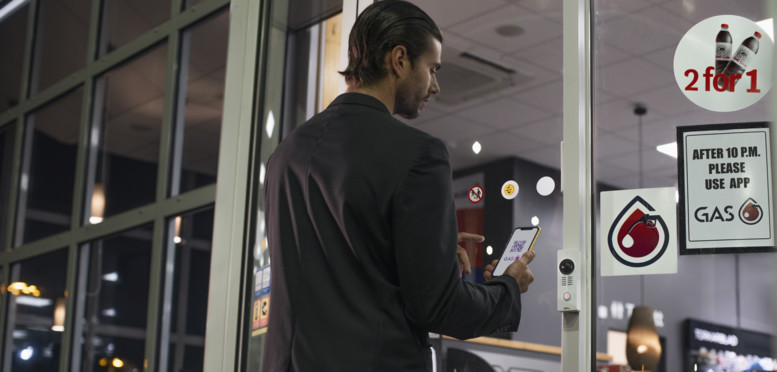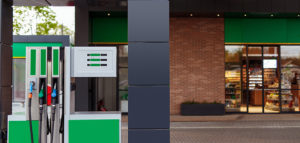Access control in retail: for improved security, efficiency and store experience
The retail landscape is constantly shifting, and so as a retailer, you are likely looking to optimize your offering to both fit the changing needs of the market and increase efficiencies in your own operations. With customer demand for a seamless, omnichannel shopping experience and digital convenience, technology is increasingly being used to enhance in-store capabilities. From click-and-collect services, to automated checkouts and autonomous stores, the retail sector is now offering more and more sophisticated digital solutions to meet customer expectations.
Open IP network access control is one example of the innovative technology that is in use today. The adoption of access control solutions in retail is growing because it is convenient, easy, and quick to use for customers and staff alike. Whether it’s to enhance the store experience, restrict access to certain parts of the store, or as a security measure to protect goods from theft; the latest access control solutions can help to innovate and optimize your retail store offering.
Enabling the shift to cashierless and hybrid stores
The emergence of more advanced access control solutions is enabling the shift to cashierless, or hybrid stores, as they allow you to manage operations remotely.
For instance, you can opt for advanced scheduled door access, where access is granted within a set timeframe. Outside of these scheduled hours, any attempted access is subject to additional security measures and requires authentications. To further enhance these measures, stores can restrict access by ensuring doors are only unlocked once approved personnel, such as a security worker, has been granted access by a specific PIN code, card number or access rule. This ‘first person in’ system is well suited to hybrid stores in particular.
To secure seamless authentication for cashierless stores, you can install network intercoms at the store entrance and exit to recognize use dynamic or static QR-codes. These can be used by the customer to allow them access to the store. Once inside, a targeted marketing message can then be played over the IP audio; such as ceiling or cabinet speakers – to further enhance the store experience, alongside a welcoming message on in-store monitors. After purchasing their goods at the self-checkout, a QR code on the customer’s receipt or mobile phone would enable them to leave by simply allowing it to be scanned by an integrated camera at the service terminal.
Should an incident occur, this type of system – where video and access control work seamlessly together – would be invaluable. For example, if a customer finds themselves unable to enter your store, the operation center can be notified in real-time, verify the customer and open the door remotely to grant them access. Additionally, you can search for instances where an ID-holder has been denied entry, and not only would you receive a log, but also video material showing the event with a synchronized time stamp. This information removes the need to search and collate different materials from two separate databases to create an account of the incident. This not only saves time and resources, but also demonstrates how store entry can be managed securely while being remotely operated.
Managing retail operations with innovative solutions
Access control can now also be used to support the management of in-store operations, with the ability to control how different areas are accessed seamlessly and securely within your premise. Integrated with edge-based intelligence, access control now allows for much more than simply letting customers through the door. When network intercoms, cameras and sensors start communicating, and smart analytics are applied, this technology can be developed to go beyond the basic functionality of analog and proprietary systems.
Introducing intelligent, IP-based access control enables the centralized management of all entry points – whether in the store itself, or in stock rooms and administrative areas. These solutions are already being used in retail delivery areas where vehicles are constantly dropping off or collecting goods, to ensure operations run smoothly.
- Typically, the delivery company registers their vehicle before arriving, and during regular working hours a gate will open once the license plate recognition application in the camera identifies the delivery truck.
- During the night an extra layer of security can be added: as soon as the camera recognizes the truck an alert is triggered to the security center. An operator then opens the gate remotely after visual verification.
With the retail industry looking for more innovative solutions to manage operations and ease staff pressure, these capabilities can be readily replicated in-store. For instance, you can now add virtually any type of credential to operate a door or a function. From more traditional access identity types such as key fobs and PIN codes to static and dynamic QR codes or license plate recognition for vehicle access, the flexible multi factor authentication methods that are now available within network door controllers present a highly secure and flexible offering.
Access control can also streamline staff movement around your store through automated processes. For instance, the use of QR codes on badges enables internal doors to be automatically opened between the main store and stockrooms. This touchless solution means your staff can move throughout the premises with minimal friction, which is particularly beneficial if they are carrying and transferring boxes of stock from one part of the store to another. This not only eases processes for your staff, but also saves valuable time, with the potential to save several hours per week.
Plus, with multi-site capabilities, these solutions can be used to monitor multiple stores in one system and across the same network, thereby easing processes.
Enhancing retail security with combined technology
Security certainly remains a top priority for retail, particularly during periods of high footfall in peak shopping times. Staff can be better supported by using the appropriate technology to ensure a high level of security, while delivering a positive service and experience for your customers.
The use of physical security devices may appear an obvious solution, with cameras having long been used in retail to deter criminal activity and ensure the safety of staff and customers. However, combining access control solutions with other security solutions like network intercoms, cameras and sensors allows for interoperability between devices. This can bolster retail security significantly, particularly within digitally-enabled stores that have less staff present.
Integrating technology with an intelligent, powerful and easy-to-use action rule engine enables you to set up rules and triggers that can elevate in-store security.
- By adding a people counter to an existing camera at the entrance, you can control access so that only one customer can enter your store at a time. This real-time detection restricts access, triggering an alarm if more than one customer With the combined use of network audio, you can inform customers of this via a predefined message or address them directly via a connected service center.
- In luxury retail, you can also use integrated solutions to protect drawers or cabinets with high value merchandise. Once the drawer is opened by a staff member, an alert is shared with employees over the speaker in the staff room. Images from a camera directed towards the drawers can be automatically displayed on the monitor in the back office, allowing staff to remotely monitor activity. Plus, with advanced access control solutions in place, doors can be automatically locked if an incident were to occur.
- You can also opt to enhance your access control solutions by creating a ‘vestibule’ with two sets of interlocking doors. This can be a particularly secure way to protect luxury goods, as it requires the first set of doors to close before the second set can open. With an integrated network video intercom, which uses two-way communication and video identification, you can operate remote entry control. This reduces the need for additional security personnel and improves security measures.
This interoperability is not limited to luxury retail, if you have potentially valuable goods, you can integrate combined solutions to bolster security and minimize risk of theft.
Scalability remains a top priority for retail solutions
One of the challenges in retail is the ability to scale in line with market demand. Being able to quickly increase the size or number of your stores provides a competitive advantage, but security solutions must be able to keep pace.
With edge-based access control, scalability and futureproofing are ensured whether there are one or a thousand doors in the system – and multi-site capabilities enable centralized control across any number of stores. Plus, this openness means adding new network intercoms, other devices or new functionalities is easy, should your business needs change over time. Intelligence on the edge also ensures solutions avoid complicated and time-consuming wiring to a central server, which simplifies any required changes as you look to scale.
Open common standards and technology platforms are key to making this a reality. Solutions from third-party suppliers can interact to provide solutions which are significantly more than the sum of their parts. These platforms are a giant leap towards making retail stores truly smart places, and provide solid foundations for you to build on.
Intelligent access control plays a role in the future of retail
As the retail sector evolves and adapts to changing marketing demand and customer preferences, the desire for more advanced access control will increase. With new intelligent features and functionalities available, you have the option to tailor and optimize your solutions to improve the overall store experience. Further still, by combining the latest innovations into one system, you can enhance your security offering to better manage operations. Ultimately, the implementation of new technology will ensure you have the capabilities to remain competitive as a retailer, both now and in the future.
Find out more about solutions for access control here.


